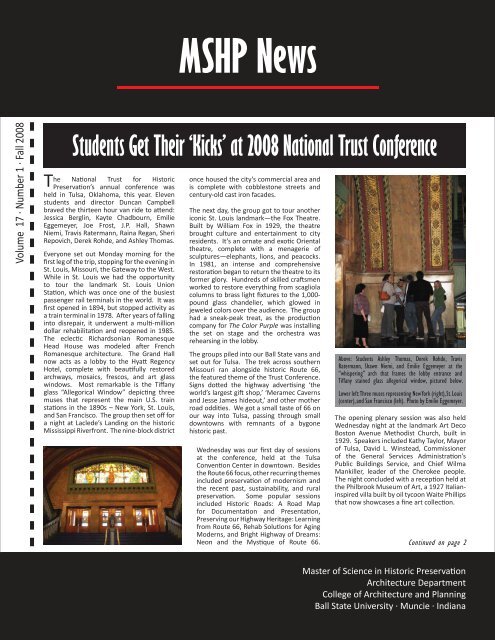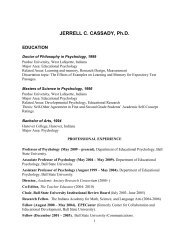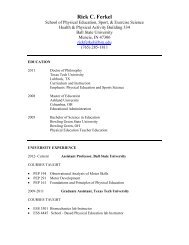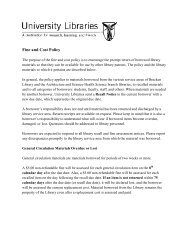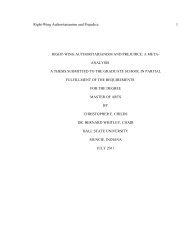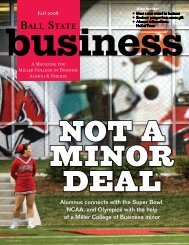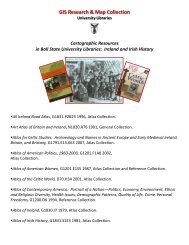MSHP News Fall 2008 - Ball State University
MSHP News Fall 2008 - Ball State University
MSHP News Fall 2008 - Ball State University
- No tags were found...
You also want an ePaper? Increase the reach of your titles
YUMPU automatically turns print PDFs into web optimized ePapers that Google loves.
<strong>MSHP</strong> <strong>News</strong>Volume 17 . Number 1 . <strong>Fall</strong> <strong>2008</strong>- - - - - - - - - - - - - - - - - - - - - - - - - -Students Get Their ‘Kicks’ at <strong>2008</strong> National Trust ConferenceThe National Trust for HistoricPreservation’s annual conference washeld in Tulsa, Oklahoma, this year. Elevenstudents and director Duncan Campbellbraved the thirteen hour van ride to attend:Jessica Berglin, Kayte Chadbourn, EmilieEggemeyer, Joe Frost, J.P. Hall, ShawnNiemi, Travis Ratermann, Raina Regan, SheriRepovich, Derek Rohde, and Ashley Thomas.Everyone set out Monday morning for thefirst leg of the trip, stopping for the evening inSt. Louis, Missouri, the Gateway to the West.While in St. Louis we had the opportunityto tour the landmark St. Louis UnionStation, which was once one of the busiestpassenger rail terminals in the world. It wasfirst opened in 1894, but stopped activity asa train terminal in 1978. After years of fallinginto disrepair, it underwent a multi-milliondollar rehabilitation and reopened in 1985.The eclectic Richardsonian RomanesqueHead House was modeled after FrenchRomanesque architecture. The Grand Hallnow acts as a lobby to the Hyatt RegencyHotel, complete with beautifully restoredarchways, mosaics, frescos, and art glasswindows. Most remarkable is the Tiffanyglass “Allegorical Window” depicting threemuses that represent the main U.S. trainstations in the 1890s – New York, St. Louis,and San Francisco. The group then set off fora night at Laclede’s Landing on the historicMississippi Riverfront. The nine-block districtonce housed the city’s commercial area andis complete with cobblestone streets andcentury-old cast iron facades.The next day, the group got to tour anothericonic St. Louis landmark—the Fox Theatre.Built by William Fox in 1929, the theatrebrought culture and entertainment to cityresidents. It’s an ornate and exotic Orientaltheatre, complete with a menagerie ofsculptures—elephants, lions, and peacocks.In 1981, an intense and comprehensiverestoration began to return the theatre to itsformer glory. Hundreds of skilled craftsmenworked to restore everything from scagliolacolumns to brass light fixtures to the 1,000-pound glass chandelier, which glowed injeweled colors over the audience. The grouphad a sneak-peak treat, as the productioncompany for The Color Purple was installingthe set on stage and the orchestra wasrehearsing in the lobby.The groups piled into our <strong>Ball</strong> <strong>State</strong> vans andset out for Tulsa. The trek across southernMissouri ran alongside historic Route 66,the featured theme of the Trust Conference.Signs dotted the highway advertising ‘theworld’s largest gift shop,’ ‘Meramec Cavernsand Jesse James hideout,’ and other motherroad oddities. We got a small taste of 66 onour way into Tulsa, passing through smalldowntowns with remnants of a bygonehistoric past.Wednesday was our first day of sessionsat the conference, held at the TulsaConvention Center in downtown. Besidesthe Route 66 focus, other recurring themesincluded preservation of modernism andthe recent past, sustainability, and ruralpreservation. Some popular sessionsincluded Historic Roads: A Road Mapfor Documentation and Presentation,Preserving our Highway Heritage: Learningfrom Route 66, Rehab Solutions for AgingModerns, and Bright Highway of Dreams:Neon and the Mystique of Route 66.Above: Students Ashley Thomas, Derek Rohde, TravisRatermann, Shawn Niemi, and Emilie Eggemeyer at the“whispering” arch that frames the lobby entrance andTiffany stained glass allegorical window, pictured below.Lower left: Three muses representing New York (right), St. Louis(center), and San Francisco (left). Photo by Emilie Eggemeyer.The opening plenary session was also heldWednesday night at the landmark Art DecoBoston Avenue Methodist Church, built in1929. Speakers included Kathy Taylor, Mayorof Tulsa, David L. Winstead, Commissionerof the General Services Administration’sPublic Buildings Service, and Chief WilmaMankiller, leader of the Cherokee people.The night concluded with a reception held atthe Philbrook Museum of Art, a 1927 Italianinspiredvilla built by oil tycoon Waite Phillipsthat now showcases a fine art collection.Continued on page 2Master of Science in Historic PreservationArchitecture DepartmentCollege of Architecture and Planning<strong>Ball</strong> <strong>State</strong> <strong>University</strong> . Muncie . Indiana
National Trust Conference, continued- - - - - - - - - - - - - - - - - - - - - - - - - - - - - - - - - - - - - - - - - - - - - - - - - - - - - - - - - - - - - - - - - - - - - - - - - - - - - - - - - - - - - - - - - - -Above: Neon motel sign along Route 66. Photo byJoseph Frost.Below: Students Kayte Chadbourn, Raina Regan, J.P. Hall,Emilie Eggemeyer, and Joe Frost at the 3-state cornerof Kansas, Oklahoma, and Missouri.Continued from page 1Thursday’s sessions included many toursthroughout Tulsa, that showcased its FederalBuildings and cultural neighborhoods, andalso farther abroad on Route 66. It wasalso a day of recent past meetings, includingChallenging Recent Past Preservation Policy,Teardowns in Suburbia: Preserving 1950s-‘60s Neighborhoods, and the Recent PastPreservation Network Annual Meeting. Theday was also filled with a four-part series ofsessions titled The Art of the Rescue, as well asgrassroots advocacy and “green” preservationpolicies.Friday was our final day of sessions. RainaRegan, a first year student with a passion forRoute 66 lore, set out west on the “MotherRoad” on the Get Your Kicks on Route 66daylong tour to Edmond, Oklahoma, exploringstructures and buildings listed in the NationalAbove: Historic building in downtown Tulsa.Below: Historic bridge on Route 66 in Sapulpa,Oklahoma. Photo by Raina Regan.Register of Historic Places along the way. Backin Tulsa, the rest of us attended sessions onrural preservation including Strategies for FarmPreservation, Can Sustainable Farming SustainHistoric Sites?, as well as sessions highlightingcommunity revitalization efforts.The conference was also a time for fun withour colleagues. Throughout the week, manyreconnected with friends from preservationnetworks, jobs, and internships. Some evengot a taste of the cowboy lifestyle with the helpof second year student, Travis Ratermann, whooutfitted us with boots, belt buckles, and hatsat the nearby western store. More studentsexplored local Tulsa attractions, including thelargest hand-crafted blue whale in nearbyCatoosa. Most of all, it was a welcomeweeklong retreat from life and school back inMuncie.On Saturday we departed, making the longjourney in one day. Leaving early in themorning, some set off straight for Muncie,while the others enjoyed a few detours alongthe way. They made stops again in St. Louisto see the Wainwright Building, one of LouisSullivan’s earliest skyscrapers, and at CahokiaMounds, just outside of St. Louis in Illinois.The site is one of the largest prehistoric sitesin the United <strong>State</strong>s. From the largest mound,Monks’ Mound, you can see the Gateway Archand Downtown St. Louis on a clear day.Overall, the trip was filled with great friendshipsand memories. We look forward to next year’sconference in Nashville, Tennessee.Above: Historic cast iron building at Laclede’sLanding in St. Louis. Photo by Joseph Frost.
Innovative Architecture Addresses Historic CompatibilityThe <strong>Ball</strong> <strong>State</strong> College of Architecture and Planning hadthe privilege of kicking off its Charlie Sappenfield GuestLecture series for <strong>2008</strong>-2009 with Gregg Pasquerelli, aprincipal architect at SHoP Architects in New York City,a firm that focuses on digital design and technology.Pasquerelli is a colleague and friend of Duncan Campbellfrom their graduate school days at Columbia <strong>University</strong>.Pasquerelli graduated from Columbia <strong>University</strong> in 1994 withhis Masters in Architecture. He and studio partner WilliamSharples, along with their wives and Sharples’ identical twinbrother, created SHoP Architecture. They forged a new kind ofpractice that was ahead of its time in the mid-1990s, using digitalfabrication software to move beyond style and the “-isms” whichcommonly plague architectural practice. Their designs testform against performance and transcend aesthetic appearance.The multifaceted office helps with design problem-solving,which elicits what Pasquerelli considers the “think-tank nature”of the office. The firm focuses on performance-based designrather than buildings that are aesthetically-based. This helpsthem understand how to design buildings that are economicalas much as they are innovative. They looked to the automotiveand aerospace industries as models in using computers tohelp deal with the complexities of fabrication and assembly.The computer software could manufacture pieces at fullscale. In doing so, it created building components that wereprecisely pre-cut and pre-measured, ready for assemblage.Right:The Porter HouseCondominiums,located in theMeatpackingDistrict ofNew York City.The projectconverted asix-story 1905warehouse intocondominiums.Designers addedfour stories tothe existingbuilding and an8-ft cantileveron the building’ssouthernexposure.“Pertinent to historic preservation advocates,” said Duncan, “agreat many of their digitally designed building are constructedin historic districts and dense urban areas containingsignificant historic resources. This firm has provided innovativesolutions in such contexts, while managing a commitmentto contemporary design and development paradigms forbuildings, planning, and landscapes. There are few firmsengaged in such exciting work, and few that have eschewedthe notion of “star” architects and “design-only” buildings infavor of cutting edge buildable structures and landscapes.”One such project is in the Little Italy Historic District. The firm hadto look at design guidelines regulating window size, scale, andmaterials. For the first time, SHoP designers had to use brick asa building material. Instead of looking at these as prescriptiveregulations, they wrote software to create pre-cast brickpatterns to form concrete panels that would form the buildingsurface. Concerning zoning regulations that prescribe the 17%of architectural detail that could extend over the property line,they simply inserted the figure into their software as one oftheir design parameters. In doing so, Pasquerelli stressed thenecessity of embedding sustainability and preservation intoperformance-based design in order to rethink the building itself.He said of the project “it’s still form to us,” and used the rulesthey were given to create parameters to guide their design.Concerning existing buildings, Pasquerelli emphasized theneed for an open architecture – to think broadly about theproblem and engage buildings in their environments. Headvocated the use of existing buildings and their incorporationinto new design as a key proponent to sustainability,considering it just another parameter guiding design. “Don’tknock down the building just to have to build another one.”Above: Plan for an addition to an existing building at the Fashion Institute ofTechnology in New York City to house a student lounge and exhibit area.All photos and renderings courtesy of SHoP Architects.- - - - - - - - - - - - - - - - - - - - - - - - - - - - - - - - - - - - - - - - - - - - - - - - - - - - - - - - - - - - - - - - - - - - - - - - - - - - - - - - - - - - - - - - - - -
Students Volunteer at Chicago Conference- - - - - - - - - - - - - - - - - - - - - - - - - - - - - - - - - - - - - - - - - - - - - - - - - - - - - - - - - - - - - - - - - - - - - - - - - - - - - - - - - - - - - - - - - - -his September, a small group of students participated in theT Traditional Building Conference held at Navy Pier in Chicago, Illinois.The Traditional Building Conference is the largest conference andtradeshow dedicated to the traditional building arts. It is sponsoredevery year by Restore Media, a publishing company that specializesin traditional trade magazines. <strong>Ball</strong> <strong>State</strong> students Jessica Berglin,Emilie Eggemeyer, Joe Frost, Jeni Gerdom, J.P. Hall, Dean Kessler, andTravis Ratermann worked with Conference Director Judy Hayward andRestore Media to volunteer their time in return for free attendance tothe conference sessions. “The volunteer work helps us, and we hopeit is a great professional opportunity for all of you,” said Hayward ofthe student participation.Students participated in many workshops, tours, and sessions—repairof historic wooden windows, restoration of the largest Tiffany stainedglass dome at the Chicago Cultural Center, architectural artworkrestoration and relocation, use of lasers to clean historic masonry, useof cathodic protection in historic steel-frame buildings to preservemasonry, among many others. It was a great learning opportunityfor all, especially with a key-note address by Donovan Rypkema,esteemed preservation economist.Below: Tiffany’s largest stained glass dome and rotunda atthe Chicago Cultural Center, photo by Joseph Frost.J.P. HallNavy Pier was a great venue for the conference, as we explored thehistoric pier and watched sailboats and yachts come to shore duringthe afternoon and evening. The rooftop terrace housed hundredsof preservationists for the Friday night reception, lit up by Chicago’sglowing skyline.On Saturday, students explored Mies van der Rohe’s Illinois Instituteof Technology campus while Duncan was at a recruiting event for <strong>Ball</strong><strong>State</strong>’s College of Architecture and Planning. Hundreds of high schoolstudents visited with representatives from architecture schools fromaround the country. While at IIT, we caught a glimpse of the KurtPerschke’s Red<strong>Ball</strong> art installation that is sweeping the globe. Theproject’s inflatable red balloon engages the public and creates a newexperience by removing the ephemeral art experience from gallerywalls and puts it in the context of urban landscape.Below: Travis Ratermann analyzes the ‘structural stability’ ofa styrofoam pillar at Navy Pier’s Halloweenland, putting allthat Preservation Technology to good use.Below: Kurt Perschke’s Red<strong>Ball</strong> installation at theIIT McCormick Tribune Campus Center designed byRem Koolhaas.O’Brien Conference Held in Bloomington at Indiana <strong>University</strong>The <strong>2008</strong> Cornelius O’Brien Historic Preservation & Indiana Main Street Conference was held in Bloomington, Indiana, on the Indiana<strong>University</strong> campus over the weekend of October 16-18. The annual conference is sponsored by Indiana <strong>University</strong>, the Indiana Division ofHistoric Preservation and Archeology and Historic Landmarks Foundation of Indiana. Many first year and second year <strong>MSHP</strong> students receivedscholarships to attend the conference along with Director of the program Duncan Campbell and Assistant Director of the Center for HistoricPreservation Susan Lankford. The conference allowed students to network with the Indiana’s leading preservationists and Main Street advocateswhile attending educational lectures, workshops, and field sessions. Many of the students got the chance to stay in the Indiana Memorial Unionlocated in the heart of the IU campus, which awarded the opportunity to explore one of the finer university campuses in the country.One of the more memorable presentations was given by Dr. Henry Glassie of Bloomington, who is one of the nation’s leading folklorists andardent preservationists. Glassie’s presentation was titled The Vernacular Landscape of Indiana, and he was both eloquent and insightful. Theweekend was capped off with a tour of Duncan Campbell’s historic Federal style home and farm located within an old Indiana limestone quarry.The students who received full and partial scholarships would like to extend their gratitude to Frank Hurdis and the DHPA, and thanks also goesout to Duncan Campbell for opening his home for all to see.
Preservation Studio Designs Residential Infi ll for Historic NeighborhoodThis fall’s Preservation Design Studio, consisting of second year <strong>MSHP</strong> students and Master of Architecture students specializing in preservation,had a unique opportunity to take part in a historic redevelopment project in an Indianapolis community. The project was spawned by theNFL Super Bowl’s selection of Indianapolis as the host of the 2012 Super Bowl. The Super Bowl Host committee decides upon a legacy project tocreate a charitable “gift” to the community as a token of appreciation for the chosen city. This particular legacy project will focus on and supportthe revitalization of a local Indianapolis neighborhood. The East 10th Street Corridor was chosen as part of the Great Indy NeighborhoodsInitiative (GINI) Quality of Life Plan. The Super Bowl Host Committee hopes to set the corridor back on a path to viability and vibrancy in thedeclining neighborhood. The John H. Boner Community Center has been the backbone to the neighborhood. In its Community Connectionpublication, it stated “The connection between a community-driven plan and Indy as a host city creates an incredible opportunity to leveragethe broader corporate and civic community to act and help our neighborhood achieve its goals…Since the announcement, there have beennumerous conversations about the role the center will play in the legacy project. Not only is the center the convening agency for the GINI project,but it is located in the heart of the near eastside. In order to strategically and successfully implement the quality of life plan, staff will work handin-handwith the Indianapolis Super Bowl Host Committee to accelerate the completion of the neighborhood’s plan.”As part of the revitalization plan, the Preservation Design Studio visited the 15-block corridor, which consists of mixed residential and commercialblocks. They surveyed the area and made recommendations pertinent to preservation, redevelopment, and sensitive demolition. Theserecommendations analyzed the corridor’s commercial feasibility as well as its opportunities for housing—through both the rehabilitation ofexisting housing fabric and the development of sensitive infill. Their project included the creation of design guidelines for the corridor. Adoptingthese guidelines, students designed historically sensitive contemporary infill, including single and multiple-family dwellings, and commercialbuildings. The goal of their designs was to preserve and enhance the historic character of the Corridor while providing feasible examples ofnew construction. The group presented their project to members of the East Tenth Street Civic Association with slideshow presentations, digitalmodels, and a fly-by digitally animated video of the 15-block corridor created by Architecture graduate student, Joseph Intriago.The following are excerpts from the studio’s guidelines:The intention of the East Tenth Street Redevelopment Guidelinesis to provide the community with recommendations for futuredevelopment and revitalization. East Tenth Street is in a uniqueposition as a result of the Super Bowl Legacy project.An important aspect of any comprehensive revitalization effort withinany community is the protection of “Sense of Place.” The purpose ofthis report is to offer guidelines for development while preservingthe unique sense of place that East Tenth Street possesses. Proposeddevelopments and initiatives along East Tenth Street should improvethe quality of life of residents and the community as a whole.Infill should be compatible to adjacent buildings and blocks. Height,massing, shape and form should all be taken into consideration duringthe development process, but contemporary interpretations andinnovative design should not be discouraged. Finding this balance canbe challenging, but it is not impossible.Examples of appropriate infi ll designs, as developed by student guidelines.Unlike some historic commercial neighborhoods, opportunities existalong East Tenth Street for large-scale infill projects due to adjacentempty lots which often span an entire city block. Large buildings arenot discouraged, but the contemporary design of this type of infillshould be sensitive to the character of surrounding blocks and theCorridor as a whole. Historically, street walls consisted of multiplebuildings that came right up to the sidewalk and which had sharedside walls, creating a unified facade. The design of each building wasdifferent but sympathetic to existing buildings in terms of scale, mass,and fenestration. It is advised that large infill construction mimic thishistoric segmenting by visual dividing the main façade into sections.Such segmentation creates a rhythm along the street wall that ispedestrian friendly. It also creates the opportunity to denote distinctcommercial enterprises by dividing a large façade into identifiablesections.Contemporary infill design can also encourage development andrevitalization. Inventive new design can infuse energy into an areathat has seen stagnant development by enhancing the character of anarea. Such enhancement can spur future investment.Upper right:Rehabilitatedcommercialstorefront.Lower right:Streetscapeshowing prevalentcommercialarchitecture.Upper left:Suggestions forsingle familyhouses.Lower left:Multiple-familydwellings, inspiredby the area’sArt Moderneinfl uences.- - - - - - - - - - - - - - - - - - - - - - - - - - - - - - - - - - - - - - - - - - - - - - - - - - - - - - - - - - - - - - - - - - - - - - - - - - - - - - - - - - - - - - - - - - -
Student Spotlights- - - - - - - - - - - - - - - - - - - - - - - - - - - - - - - - - - - - - - - - - - - - - - - - - - - - - - - - - - - - - - - - - - - - - - - - - - - - - - - - - - - - - - - - - - -Planning Student Raises Awareness About Downtown MuncieStudent Editorial—Jennifer GerdomAs a <strong>Ball</strong> <strong>State</strong> student with an interest in subjects like urbanplanning and historic preservation, being involved in adowntown is important to me. Moving to a new place, I was excitedto spend time in downtown Muncie, but soon noticed little tono students present. I was new to the area, and thought, “Okay,it’s the beginning of the school year and people are still gettingsettled.” As time went on, there were still very few patrons from<strong>Ball</strong> <strong>State</strong>. I have noticed that The Village is crawling with students,and I started asking myself, “Why?” What does The Village offerthat downtown does not? First, the Village is closer to campus; it ispractically part of campus, and the limited parking around there willprove that. Downtown is not quite as close, but did you know thatit is almost the same distance away as <strong>Ball</strong> <strong>State</strong>’s stadium? UsingShafer Tower as a landmark, it is approximately 1.5 miles from thestadium, translating to roughly 4 minutes by car and 25 minutes byfoot. From Shafer Tower to Kirk's Bike Shop (located downtown) itis a mere 1.7 miles, translating to approximately 7 minutes by carand 33 minutes by foot. So then, what’s the problem? For thosethat don’t have their own transportation or don’t want to walk andprefer to ride public transit, the <strong>Ball</strong> <strong>State</strong> Shuttle buses run to thestadium, but not downtown. But alas, the MITS buses run from<strong>Ball</strong> <strong>State</strong> and can drop you off at their bus station, which is locatedright at the heart of downtown Muncie! So now we have almostequal distances from the far side of campus and from the corners ofWalnut Street and Jackson Street.Also, The Village offers an urban setting and feel. It is enjoyable towalk around, and hot spots are in close proximity to one another.There are places to eat and meet with friends and to take part inother leisurely activities. Downtown Muncie also offers an urbansetting and feel, and many easily-accessible hot spots. The nameThe Village even suggests it is a place which provides a relaxing andenticing atmosphere, in which one may relax in an urban settingthat somehow manages to provide a small-town ambiance. Canyou think of another place that also offers a strikingly similarexperience?After speaking with a number of students, it was shocking to findout that people who have been here as long as three years havenever been downtown, except to work on a school project. Whois to blame, the students for not exploring? The university for notadvertising what is to offer downtown? The city of Muncie itself,for not making a stronger effort to appeal to students? Perhaps acombination thereof? No matter who is to blame, we are wherewe are, and we need to work together to get out of our currentsituation. When I look at Muncie, I see opportunity, potential, andappeal. If you want great cup of coffee to wake you up, Muncie hasit. If you want a unique dining experience, Muncie has it. For thoseof you who are of age and would like to go to a bar not too closeto campus, Muncie has it. There is a historic theater downtown;campus is not the only place to watch a live play. There ARE thingsto do in downtown Muncie! All you have to do to find them iskeep your eyes open. If you look hard enough, you will noticethat businesses want students, which is proved by the studentdiscounts offered by them! Understandably, students may nothead to downtown because the chances of running into friends, likeyou can easily do on campus, are slim, but that is because they arein the same boat as you! Nobody seems to know what is offereddowntown, so nobody seems to go. It is a catch-22, if you will.Living downtown is yet another unique experience you can’t get oncampus. For those of you who would like to “take a break” fromcampus, living downtown is the perfect way to do so. After a longday of school, getting out of that atmosphere and into anothermight be exactly what the doctor ordered. Did you know thereare numerous living opportunities downtown? I wasn’t sure howmany students knew, until I found out some were on a waiting list!There are a number of apartments above retail stores and otherbusinesses that are available for rent, but most are full, and studentsare patiently (and perhaps impatiently) waiting to move into one.Perhaps it needs to be made known that there is a large demandfor downtown living arrangements, which, in turn, might show thecity of Muncie, real estate investors, and landlords that they needto refurbish more buildings with upstairs apartments, allowingstudents to move in. Maybe if the people come first, the retail willfollow. Regardless, mixing downtown Muncie and students whoalready live approximately 7 minutes away by car, just seems tomake sense. However, a major obstacle may be affordability. Yes,we all know the “I’m a broke college student,” phrase, and beingable to choose where to live is not always an option. If downtownMuncie could find a way to cater to students, keep living affordablefor students who appreciate a historic downtown atmosphere, andcan prove to be responsible about it, then it could be a win-winsituation!As for the direct benefits to Muncie, keeping the downtown areaviable is very important. I don’t think anyone would want to watchMuncie fall back into somewhat of a “dead zone” as it did a decadeor so ago. Muncie has bounced back beautifully, and I think thatwe students, as the younger generation, should be involved inrevitalizing areas such as downtown Muncie. It is a shame to watchbeautiful old buildings, original planning, and that old-time feel ofdowntown areas disappear.If you are interested further in learning about how you can becomeinvolved with downtown Muncie, there are groups you can becomeinvolved with (check out downtownmuncie.com). You can alsolog onto facebook.com and search for <strong>Ball</strong> <strong>State</strong> Students LoveDowntown Muncie, which, as the name hints, is the beginning of astudent organization to connect <strong>Ball</strong> <strong>State</strong> students and downtownMuncie. <strong>Ball</strong> <strong>State</strong> is Muncie; Muncie is <strong>Ball</strong> <strong>State</strong>. A properconnection must be made, and students have the most powerfulvoice for creating this connection. We need each other. Pleasebecome involved.
Raina ReganDuring the National Trust Conference in Tulsa, Oklahoma,I spent Friday on the field session "Get Your Kicks onRoute 66 – West to Edmond, Oklahoma." Led by two Route66 photographers, Jim Ross and Shellee Graham, we startedin Tulsa and stopped in several Route 66 towns to Edmond,Oklahoma. In Sapulpa, Oklahoma, we stopped to see a 1924parker through truss bridge, Bridge No. 18 at Rock Creek. Theoriginal brick road from Route 66 was visible in parts on thebridge. The bridge was a definite highlight of the entire day, asit remains in good condition and the bridge is still in use.Our next stop on the tour took us to Bristow, Oklahoma, whereseveral motor companies and service stations are still in usefrom the Route 66 era. Five of these sites are listed on theNational Register, including the Bristow Mother CompanyBuilding, which was built in the 1920s and retains most of itshistoric features.The best part of the tour came in Stroud, Oklahoma, when wewere able to visit the remains of the Rock Café and meet itsowner, Dawn Welsh. This iconic Route 66 café was the victimof fire in May <strong>2008</strong>, but the strong Rock walls survived thefire and the structure will be rebuilt. We were able to talkat length with Welsh, who recalled the entire history of thecafé and shared interesting stories about the people she hasencountered over the years. Dawn Welsh was the inspirationWestward Bound on the Mother Roadfor the character Sally in the Pixar movie Cars and she sharedher experiences with the Pixar creative team, including herattendance at the movie premiere! Listening to her stories,I really gained a true appreciation for the business owners onRoute 66.The next main stop along the way was in Chandler, OK, wherethe tour stopped at the Chandler Armory, which was beenrehabilitated to serve as the Route 66 Interpretive Center. AfterChandler, we drove through the cities of Warwick, Wellston,and Luther, noting filling stations in each city.The last stop of the day was in Arcadia, Oklahoma, where theArcadia Round Barn is located. Originally built in 1898, thebuilding experienced neglect over the years, but was restoredin the 1990s and is open for visitors. Lastly, we stopped atthe new Pops gas fillingstation. Opened in2007, it was designed topay tribute to Route 66.There is a large sodabottle out front andinside, the restaurantoffers over 600 bottledbeverages for sale.The day was a great wayto experience Route 66and get a small tasteof the life along theMother Road!Right: Iconic Rock Caferoadside sign. Photo byRaina Regan.Left: Rebuilding the RockCafe after a fi re in May<strong>2008</strong>. Photo by RainaRegan.- - - - - - - - - - - - - - - - - - - - - - - - - - - - - - - - - - - - - - - - - - - - - - - - - - - - - - - - - - - - - - - - - - - - - - - - - - - - - - - - - - - - - - - - - - -
Second-Year Student Updates- - - - - - - - - - - - - - - - - - - - - - - - - - - - - - - - - - - - - - - - - - - - - - - - - - - - - - - - - - - - - - - - - - - - - - - - - - - - - - - - - - - - - - - - - - -Derek RohdeDerek interned at the <strong>University</strong> at Buffalo Archaeological Survey, where he performed CRM archaeological investigationsthroughout Western New York. His most memorable experiences include the trips to the National Trust and O'Brien Conferencesand also the always exciting get-togethers with everyone from the program. Derek is glad that everyone in the programbonded really well and feels like everyone is part of one big "preservation family." What Derek likes about the program is theability to take courses outside of the College of Architecture and the opportunity to have a graduate assistantship.Chris PrattChris spent the summer living and working in the Boston area where she was employed as a monument survey intern withMount Auburn Cemetery, a National Historic Landmark and the first large-scale designed landscaped cemetery in the nation.When she wasn’t surveying historic gravestones, creepy mausoleums, and cast iron fences, Chris lounged on the nearby beachand worked diligently on her thesis. Her thesis examines the availability and use of manufactured and imported buildingmaterials in central and southern Indiana before 1850.After graduation, Chris will continue at <strong>Ball</strong> <strong>State</strong> where she is pursuinga second master’s degree in Anthropology with a focus in Historical Archaeology. In other news, she and her husband, Justin,are eagerly awaiting the birth of their first child in February.Sheri RepovichSheri Repovich spent this past summer in Spokane, Washington working at the Campbell House, a historic house museum.The Campbell House is run in conjunction with the Museum of Arts & Culture. The internship consisted of writing a HistoricInterior Restoration Plan and designing and building museum displays for the "Spokane Time Line" gallery. Her favoritememories at <strong>Ball</strong> <strong>State</strong> have been the National Trust trips and time spent with friends outside the classroom.Kayte ChadbournKayte Chadbourn worked her summer internship with Colorado Preservation, Inc. in Denver, Colorado. For the EndangeredPlaces Program she travelled around the state giving public presentations about the non-profit and how nominating sitesto Colorado's Most Endangered Places List would benefit the preservation process. She also visited previously listed sites,updated the program's website, and put together a brochure that described the seventy sites already listed. Her favorite partof the summer was helping to stabilize an 1881 railroad depot for two weekends with volunteers in the mountain town ofComo. She is very thankful for the experience and has enjoyed her time in the program with her fellow <strong>MSHP</strong> students.Ashley ThomasAshley worked at <strong>Ball</strong> <strong>State</strong> <strong>University</strong>’s Center for Historic Preservation over the summer for her internship. Her favoriteexperience while in the preservation program is the National Trust for Historic Preservation Conference in Tulsa, Oklahoma.She is writing her thesis on the history and rehabilitation of country grain elevators in Delaware County, Indiana. Aftergraduation she plans on finding a job that fits with her love of rural structures and landscapes.Shawn NiemiQuickly making Indiana his home away from home, Shawn spent most of the summer days in nearby Tipton County.His internship with Historic Landmarks Foundation of Indiana as an architectural surveyor was highly rewarding andprovided a unique opportunity to explore Indiana’s rural landscape. Capping his summer was a trip to Guatemala,where he volunteered at a local orphanage. More recently, the student/faculty trip to Oklahoma provided severalmemorable moments, including a visit to Bartlesville, Oklahoma, and a tour of Frank Lloyd Wright’s Price Tower.Emilie EggemeyerEmilie served her internship at the Illinois Historic Preservation Agency in Springfield, Illinois. In particular, she worked inthe <strong>State</strong>’s National Register of Historic Places office and spent her time reviewing, editing and writing National Registernominations, as well as travelling throughout the state checking out interesting properties. Behind-the-scenes tours on thesetrips were her favorite! Her favorite <strong>Ball</strong> <strong>State</strong> moments have to be all the fun times spent with classmates working in thestudio. After graduation, she hopes to find a preservation job in the Midwest to stay close to her family and she plans onreturning to Germany sometime in the near future.Travis RatermannTravis worked For the Illinois Historic Preservation Agency in Springfield, Illinois. He worked in conjunction with the NationalPark Service's Route 66 Corridor Preservation program to survey the abandoned Route 66 roadbed segments throughoutIllinois. From gun shots to windmills he saw all of his home state of Illinois over the summer. From here he doesn’t knowwhere he’s going, but hopes it involves a job.J.P. HallJ. P. Hall is originally from Naperville, Illinois, but has spent much of his life in northern Indiana. His first love is history whichfuels his passion for historic preservation, art, and architecture. J. P. did his internship for the Center for Historic Preservationat <strong>Ball</strong> <strong>State</strong> and developed a Cultural Heritage Tourism study for Noblesville, Indiana. This study further instilled in J. P. thebenefits historic preservation can have within a community both economically and culturally.
Introducing First-Year <strong>MSHP</strong> StudentsDean KesslerDean is from Highland, Indiana, and attended <strong>Ball</strong> <strong>State</strong> <strong>University</strong>, where he majored in Public History with a minor inArchitecture. As part of his undergraduate degree requirements, he had to complete a semester-long internship in his careerfield of choice. That being said, Dean interned with the Historic Landmarks Foundation of Indiana, Calumet Region Office,under the direction of Tiffany Tolbert. He enjoyed his time there very much, and the excellent learning experience that iswas solidified his decision to become a Historic Preservationist. Dean first became fascinated with history and preservation,though, back in the fifth grade when his social studies teacher showed the class a book detailing historic homes of hischildhood town. He has since then traveled to many historic sites throughout the Midwest, stretching to the East Coast.Raina ReganRaina is originally from Fenton, Michigan and obtained her Bachelor of Arts in Art History and Visual Culture from Michigan<strong>State</strong> <strong>University</strong>. She has had an interest in history and public policy from a young age, while gaining an interest in designand architecture while studying at Michigan <strong>State</strong>. All of these interests inspired her to continue her education in historicpreservation. Raina's other interests are playing saxophone and flute, painting, traveling, and hopefully, one day, publishingher first children's book.Megan HopkinMegan M. Hopkin is a first year <strong>MSHP</strong> student from West Newton, Pennsylvania. She has her Bachelor's Degree in LiberalArts and Sciences from West Virginia <strong>University</strong>. Megan became interested in preservation when she was able to travel toMonticello and Montpelier. She worked at Friendship Hill National Historic Site in Point Marion, Pennsylvania, which gave heranother opportunity to explore the field of preservation. Besides, traveling to different national parks and historic buildings,Megan enjoys reading, dancing, baking and traveling to her undergrad alma mater.Joseph FrostJoe is from Davison, Michigan, near Flint. He attended Michigan <strong>State</strong> <strong>University</strong>, where he received a B.A. in Geography. Forthe past eight summers, Joe has worked as a Historic Interpreter at Fort Mackinac. He has a wide range of interests that varyfrom military history, maritime history, and an uncanny love for the Italianate style of architecture. Joe collects antique books,and his prized possession is his 1930s radio. Remember kids, "all history stopped in 1945!"Trinity Hart-VavraTrinity Hart-Vavra was born and raised in Oregon. She received her BA in Social Science and International Studies from a"podunk" private liberal arts school (Colorado Christian <strong>University</strong>) outside of Denver in 2002. Since then she has beenteaching, traveling, and teaching while traveling. Though always interested in historic architecture, especially after living inRussia, her interest in preservation generally began when she was living in Japan. She has called Indianapolis her home sincereturning from Japan in the summer of 2007 and lives there with her husband, two cats, and four chickens. She misses themountains and snow.Janette AmstutzJanette lives in Goshen, Indiana with her husband, three children, and a dog. She graduated from college way back in 1986with a degree in elementary education and has lived in many places since then. The most interesting place was in Egypt,where she taught 4th and 5th graders in a private Egyptian school for three years. It was a great experience. Her oldest sonwas born in Cairo and that added to the experience. She has been working at home raising her children for the past 18 yearsand began substitute teaching 7 years ago. Architecture and old things have always interested Janette, who says “Comingback to school to study historic preservation is an exciting adventure for me.” When she is not teaching, running my childrenaround or studying, she enjoys working in her flower beds, vegetable garden, and a very small fruit orchard. Lastly, with herdaughter’s interest in the Twilight book series, she went to see the movie and began reading the books. “I am hooked andalmost ready to begin the fourth and final book. I know they are teen books but I am 46 and I am enjoying a fun easy read!”Jessica BerglinJessica is from Des Moines, Iowa, and attended Iowa <strong>State</strong> <strong>University</strong>, where she studied Art and Architecture History. Herinterests in preservation stem from exploring historic neighborhoods back home and her passion for historic architecture.She loves traveling to places of historical and cultural distinction, and living in Newport, Rhode Island, solidified her interestin preservation. Jessica also had the opportunity to study architecture in the Czech Republic and throughout Eastern Europeand hopes to someday return. Besides architecture, her passions include hand-thrown pottery, antique furniture, andshoes.Maianne PrebleMaianne is from Minneapolis, Minnesota. She went to the Savannah College of Art and Design and received her B.F.A. inHistoric Preservation.- - - - - - - - - - - - - - - - - - - - - - - - - - - - - - - - - - - - - - - - - - - - - - - - - - - - - - - - - - - - - - - - - - - - - - - - - - - - - - - - - - - - - - - - - - -
At the Center for Historic Preservation- - - - - - - - - - - - - - - - - - - - - - - - - - - - - - - - - - - - - - - - - - - - - - - - - - - - - - - - - - - - - - - - - - - - - - - - - - - - - - - - - - - - - - - - - - -Ashley ThomasOver the past summer, the Center for Historic Preservation worked on several different projects. These included twoHistoric Structure Reports for the Duck Creek Aqueduct and Lock 25 at the Whitewater Canal <strong>State</strong> Historic Site and a surveyof buildings in “Old Town Carmel” in Carmel, Indiana to determine the potential for a historic district. There was also a conditionassessment of the George Houck House in Centerville, Indiana, and a heritage tourism plan developed for the town of Noblesville,Indiana.This semester, the projects include two more historic structure reports and work in several Main Street communities. The historicstructure reports are for the Cabin and Carriage House at Limberlost <strong>State</strong> Historic Site in Geneva, Indiana. The Main Street projectsare located in Nappanee, Evansville, and Greensburg. In Nappanee, the work is focused on recommendations for addressingsecond story windows and interpretive signage. The work for Evansville involves developing guidelines for the streetscape. Andthe project in Greensburg involves guidelines for a real estate consortium.The historic structure reports discussed in this newsletter havebeen funded in part by a grant from the U.S. Department ofthe Interior, National Park Service Historic Preservation Fund,administered by the Indiana Department of Natural Resources,Division of Historic Preservation and Archaeology. However,the contents and opinions do not necessarily reflect the viewsor policies of the Department of the Interior or the Departmentof Natural Resources. Additional funding was provided by theDepartment of Natural Resources, Division of <strong>State</strong> Museumand Historic Sites.First-Year Students Receive CAP ScholarshipFriends of the Program:Thanks to all of you who have found the time and resources tocontribute to our graduate preservation program. You have helped buildour HP Foundation account and enabled us to assist students attendingnational conferences - $100 per student to Tulsa last fall - and meetmultiple program needs.This year we have established a separate Foundation account for theCenter for Historic Preservation, thanks to a generous contribution fromJosie and Geoff Fox. This means that your future donations may nowbe earmarked either for the Graduate Program or the Center, as youprefer.Unfortunately, we will probably never be so fortunate that we willcease asking for your help. Soon you will receive a special plea fromme and Marsh Davis, an alum, Center advisor, and President of theHistoric Landmarks Foundation of Indiana. Our objective is, of course, toencourage your fi nancial assistance, but also to inform you of the workof the Center and its critical importance in helping to provide muchneeded fi eld experience to our graduate students, while advocating andactivating preservation programs in cities and towns across the state andregion. We know that times are diffi cult. Anything you can contribute,however meager, we promise to use to enhance preservation education,build better opportunities for our students, and bring renewal to ourcommunities. Thank you.--Duncan CampbellFirst year students Jessica Berglin, Joseph Frost, Megan Hopkin, Dean Kessler, Maianne Preble, and Raina Regan wereawarded scholarships through the H. Wayne Standerford and Jewel Standerford Endowment, which was created “to providescholarships for students desiring to seek an education in the architectural school of <strong>Ball</strong> <strong>State</strong> <strong>University</strong>.” The HistoricPreservation Program awarded the scholarship to the six incoming students with the highest undergraduate grade point averages.The students were among many within the College of Architecture and Planning to receive scholarships through variousendowments. All recipients were recognized at an awards reception held on November 1, <strong>2008</strong>. The reception provided anopportunity for students to meet their gracious donors who have contributed so much to the College of Architecture and Planning.As a thank-you, recipients created personalized art cards to give to their donors. Associate Dean of the College, Michel Mounayar,initiated the art cards in hopes of creating a new tradition at the college. All cards were collected and copied into a digitalcollection before they were given to the donors. The collection will be added to in upcoming years by future scholarship recipients.Congratulations first years, and thank you to all of the donors to the College of Architecture and Planning.
DirectionsThe preservation movement has one greatcuriosity. There is never retrospectivecontroversy or regret. Preservationists are theonly people in the world who are invariablyconfi rmed in their wisdom after the fact.-John Kenneth GalbraithI would like to introduce myself to you as the recently appointeddirector of the graduate program in historic preservation by way of afew words, appropriately, about my past.First, I am a Hoosier who grew up in Indianapolis. I left home after highschool in 1963 for New York and Columbia <strong>University</strong>, where I majoredin Latin American History with a minor in Spanish, received an excellenteducation in urban living, and like most students, particularly in thefabled sixties, got my eyes opened. In 1970 I moved to Bloomington,Indiana, where until my recent move to Muncie, I have made my home.As with many of my contemporaries, after college I eschewed myformal education for all things organic and natural and began lookingaround for something more tangible to “do with my life.” I wanted to bean organic farmer, but as with most of us, necessity guided choice, andI became a carpenter and contractor, a trade I plied for nearly twentyyears, first as a remodeler and eventually as a restorer.In 1990 I left the trades for graduate school, returned to Columbia foran <strong>MSHP</strong>, and came back to Bloomington to co-found a preservationconsulting firm, Preservation Development Inc., which operated until<strong>2008</strong>. In the spring of 2007, my predecessor, Dr. Glass, enlisted me toteach the Economics course. When he resigned to return to the SHPO,he asked if I would direct the Center for HP for the summer. By thefall I was asked to teach for the 2007-08 academic year, and at theturn of semesters when Dr. Glass’s position as director of the programwas advertised, I applied for the job and received the appointment.I would like to say that I couldn’t have planned it better, since this isa dream job, but as you can see a combination of unforeseen eventscoupled with being in the right place at the right time can be a realcareer booster.I wanted to call this portion of the newsletter “Directions” partly as aplay on “director,” but mostly because I intend to use this space twicea year to share my aspirations for the graduate program in historicpreservation. I hope to discuss program alternatives and changes,strengths and weaknesses, and hopefully elicit from you, many if notmost of who are students and alumni, your opinions and suggestions—your directions to me—for making our program one of the very best.Faculty who listen to their students often remark (with some surprise)how insightful they are when it comes to evaluating what works andwhat does not in the program curriculum. At a recent architecturedepartment faculty retreat, the student participants offered some ofthe most thoughtful reflections on how we do what we do. Queried byme, one said, “We think about this stuff and talk to one another aboutit all the time.” I propose that this be a place where that discussioncan take place—a place to discuss the program, pressing issues inpreservation, and ways to assure that each informs the other. Asstudents and former students, I hope you will participate and benefitfrom such an exchange; I know it will help the program to providefuture students with an even better education. To widen the formatfor the discussion, and to grow the participation, I plan to start a blogthis semester through which we can talk to one another about thechallenges, trends, and goals of preservation education and practice.I have only been exposed to our graduate program for a short time,barely two years. But I would like to comment on what I have observed,not to criticize, but to observe critically.First, a few of our courses overlap and are redundant. This is not the faultof our faculty, regular or adjunct, but is partly a result of our necessarydependence on adjunct instructors, who have the unfortunateexperience of being visitors to the program, often unsupported by therest of us, and isolated from one another and the larger concerns ofthe department. While they are diligent in their efforts to provide asalient classroom experience, there is little opportunity for them tosit down together and decide who is going to teach what. As a result,for example, our introductory courses and our documentation coursesteach a lot of the same material, only to be followed by coursesspecifically designed to teach that material in more depth, specificallythe law and economics courses. We need to better coordinate thesyllabus of each to reduce the overlap, and by doing so, create space ineach for a greater diversity of subject matter.Second, I do not believe that we need two semesters of documentation.Few other programs offer more than one. Currently, the first semesterseems to adequately cover the basic information, and the second isdedicated to National Register nominations and instruction. If weeliminated the overlap that the first semester has with our introductorycourse, we could add National Register skills to the syllabus. Moreover,and you will probably hear more from me about this, teaching someoneto write a specific National Register nomination is not nearly so criticalas teaching one to construct historical significance, especially at atime when preservation’s boundaries are rapidly expanding. We needto forego the impulse to teach specialists and concern ourselves withteaching analysts, thinkers, and advocates.Third, I am currently working to broaden our students’ choice ofelectives, both within CAP as well as across other programs and colleges.Our graduate students are adults; we are teachers and advisors. Let’shelp them make choices that they believe will advance the educationthey want as well as the one we believe they will need. I will alsoencourage our faculty to offer new elective courses to broaden theprogram. There is little room in the curriculum, but new courses couldbe offered every other year, giving each class at least one opportunityto take them.I currently encourage all CAP students I encounter, undergraduate aswell as graduate, to participate in our courses as much as possible. Thiscross fertilization is crucial—after all, preservationists have to live andwork with architects and planners and landscape architects every dayin practice, they may as well begin here. We cannot bring preservationeducation to the other CAP students, especially the undergraduates,without expanding our collaboration efforts, opening the doors to ourprogram, and encouraging our students to work in other departments.In the last year we have nearly doubled the number of Master ofArchitecture students who concentrate in historic preservation. Alongwith our other courses, this offers them the Preservation Design Studiowhere they can work side by side with our students—a healthy situationfor both that expands our capacity to teach more design.Finally, I would like to see us offer a colloquium in which studentsread primary source materials, essays, criticism, and commentaryin preservation practice and theory. Currently I envision this as anexit course, perhaps team-taught in the final semester to all secondyear students. The objective would be to create a framework for thetwo-year curriculum, to give perspective to graduating students byimmersing them in the literature of preservation, providing exposureto both the good and bad of our past practices, and building a body ofinformation to help graduates make smart and ethical choices in theircareers.If you have suggestions and ideas for making our graduate program abetter, more fulfilling, and more useful one, please let me hear fromyou.-Duncan Campbelldcampbell@bsu.edu- - - - - - - - - - - - - - - - - - - - - - - - - - - - - - - - - - - - - - - - - - - - - - - - - - - - - - - - - - - - - - - - - - - - - - - - - - - - - - - - - - - - - - - - - - -
Graduate Program in Historic PreservationCollege of Architecture and Planning<strong>Ball</strong> <strong>State</strong> <strong>University</strong>Muncie, IN 47306NONPROFIT ORG.U.S. POSTAGEPAIDBALL STATEUNIVERSITY<strong>Ball</strong> <strong>State</strong> <strong>University</strong> . Master of Science in Historic PreservationThe <strong>MSHP</strong> <strong>News</strong>Editor and Designer: Jessica BerglinFaculty Advisor: Duncan CampbellFor program information, write:Duncan CampbellDirector . Graduate Program in Historic PreservationCollege of Architecture and Planning . <strong>Ball</strong> <strong>State</strong> <strong>University</strong>Muncie . Indiana . 47306(765) 285-1920preservation@bsu.eduwww.bsu.edu/preservation


